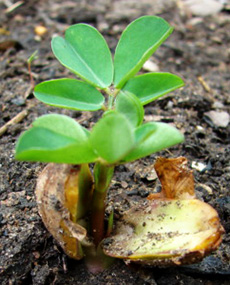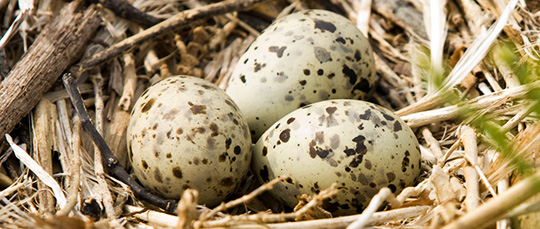
Illustrated by: Sabine Deviche
It's the Season

What is your favorite season? Is it spring, when you can go on hikes and the days start to get longer? Maybe it is fall, when the summer heat has passed and the leaves are changing color. Many things change during the four seasons (spring, summer, fall, and winter), including the temperature and the amount of rain that falls. Plants and animals also change with the seasons.
When spring comes, warm temperatures and rain help plants to bloom and set insects abuzz. Plants and insects are important food items for many larger animals, so as plant and insect activity increases, so does the activity of the animals that eat plants and insects. When a lot of food is available, animals can get enough to eat, and there is enough food for their babies (also called young). Because of this, many animals have their young in the early summer, soon after plant and insect numbers begin to increase.
This means that animals that live in seasonal environments have to change their behavior to match the season. If a bird has its young in the late summer when there is not enough food, its young might not survive the winter. For these animals, knowing the season is a matter of life and death.
Changing with the Seasons

How do animals know what season it is? They don’t have calendars or school holidays, so they have to find something in their environment that will tell them the time of year. This is called an environmental cue. Birds use the length of the day as an environmental cue because it changes throughout the year in a very regular pattern. Days begin to get longer in the spring, and then begin to get shorter in the fall. This is why the days are longer during the summer than the winter, and you might get to play outside later in the evening.
When an animal changes in some way in response to changes in day length over the year, we call them photoperiodic. Many different animals are photoperiodic, such as the common garden snails that are probably in your backyard or neighborhood park. When the days begin to get longer in spring, this little snail lays eggs. Because it lays eggs depending on the length of the day, we call its reproduction photoperiodic.
Even though the common garden snail’s reproduction is photoperiodic, other factors may affect its reproduction. If the snail is too young or too small, for example, it may not lay eggs even if the day length is increasing. If this happens, then we can say they are not sensitive to day length, even though they are usually photoperiodic. In this case, they have to grow to a certain size before becoming sensitive to day length. But some animals can actually change their sensitivity to day length during a single year.

Let’s take a closer look at birds. Like the snail, birds lay their eggs in the spring, when the length of day is increasing. This timing is perfect, as this is also the time of year that more food is available. During this time, birds are sensitive to changes in day length.
However, the day length keeps increasing throughout the summer. If the birds remained sensitive to day length, they would lay eggs all summer long, and their nests would be overflowing with young. Instead, birds gradually lose their sensitivity to changes in day length in the summer, so they will stop laying eggs. Then they can devote all of their time to taking care of the eggs they have already laid.
So how can an animal change their sensitivity to day length? They do this by changing how their brains respond to light.
The Rufous-winged Sparrow

The Rufous-winged sparrow (Peucaea carpalis) is an unusual bird that may help us understand how birds change their sensitivity to light. This bird lives in the Sonoran desert, where plants don’t bloom in the spring; they bloom in the late summer, when the monsoon rains bring the desert to life.
If the Rufous-winged sparrow began laying eggs when the day length started increasing, its young would hatch too early, and they would not have enough food to eat. Instead, the Rufous-winged sparrow waits until after the monsoon rains to lay eggs. It is able to do this because it has changed how its brain responds to light, or to say it another way, it has changed its sensitivity to day length.
We could learn a lot about how animals adapt to their environments by finding out how the brain of the Rufous-winged sparrow is different compared to the brains of other birds. Professor Pierre Deviche from Arizona State University thinks these differences are most likely due to changes in a part of the Rufous-winged sparrow’s brain that controls hormones.
Hormones control reproduction in most animals, and birds are no different. They lay eggs in response to hormonal changes in their bodies. The Rufous-winged sparrow, though, seems to have changed how its body produces hormones in response to light. This means that this little desert sparrow could answer big questions about how animals first became sensitive to changes in day length.
Read more about: Singing in the Rain
Bibliographic details:
- Article: Singing in the Rain
- Author(s): Alex Brashears
- Publisher: Arizona State University School of Life Sciences Ask A Biologist
- Site name: ASU - Ask A Biologist
- Date published:
- Date accessed:
- Link: https://askabiologist.asu.edu/explore/animals-seasons
APA Style
Alex Brashears. (). Singing in the Rain. ASU - Ask A Biologist. Retrieved from https://askabiologist.asu.edu/explore/animals-seasons
Chicago Manual of Style
Alex Brashears. "Singing in the Rain". ASU - Ask A Biologist. . https://askabiologist.asu.edu/explore/animals-seasons
Alex Brashears. "Singing in the Rain". ASU - Ask A Biologist. . ASU - Ask A Biologist, Web. https://askabiologist.asu.edu/explore/animals-seasons
MLA 2017 Style

A colorful sonogram shows what the vocals of a Rufous-winged Sparrow looks like. Listen and learn more about this sparrow in our Bird Finder.
Be Part of
Ask A Biologist
By volunteering, or simply sending us feedback on the site. Scientists, teachers, writers, illustrators, and translators are all important to the program. If you are interested in helping with the website we have a Volunteers page to get the process started.

